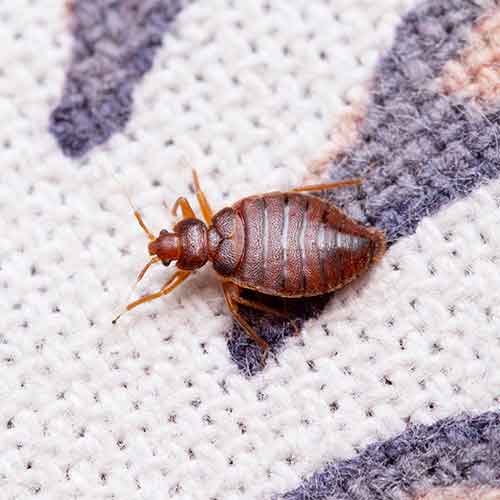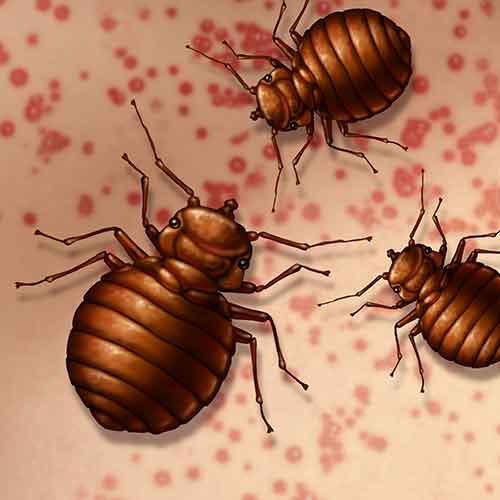Don’t Battle a Bed Bug Infestation Alone, Turn to the Team at Smash Pest Control
There is nothing as unsettling as waking up covered in itchy bites until a more sobering thought crosses your mind: are there tiny uninvited intruders sharing your bed? Don’t panic, but do take action. While a bed bug infestation is definitely upsetting, these pests are treatable. Go to the experts at Smash Pest Control to take down these nocturnal bloodsuckers. Reach out to us now for effective bed bug solutions.

How Big Are Bed Bugs?
Female bed bugs lay eggs in clusters of about 10-50 eggs. The eggs are tiny at about one millimeter in size (picture a poppy seed), and the incubation period lasts about six to ten days. The life cycle of a bed bug consists of several stages, including egg, nymph, and adult. Under typical room temperatures and feeding conditions, bed bugs can reach full maturity in just four to six weeks.
Bed bugs range in size depending on where they are in their development. They go through five instar stages before reaching adulthood. Each instar requires a blood meal to molt and progress to the next stage. At their smallest, newly hatched bed bugs are a millimeter and a half on average. For a comparison, that’s about the size of the head of a standard sewing pin. Their translucent appearance can make it hard to see them. When they feed, their bodies have red markings at the center which makes them easier to spot. An adult bed bug is four to five millimeters on average, which is similar in size to an apple seed.
How Do I Know if I Have Bed Bugs?
Bed bugs are some of the most difficult pests to treat because they can fly under the radar at the beginning of an infestation. It’s important to be able to recognize the early signs:
- Bed bug bites. Bites are often the first clue that you could have a bed bug problem. Look for itchy, red bumps on your skin. They often appear in lines or clusters and may be especially noticeable when you wake up in the morning.
- Blood stains on bedding. Carefully check your sheets, pillowcases, and mattress seams for small brownish-red stains. These spots could be dried blood left behind when you roll over in your sleep and unknowingly squash a recently-fed bed bug.
- Dark fecal spots on linen and mattress. Look for tiny, dark spots or smears on bedding, mattress seams, or nearby furniture. These are bed bug feces.
- You find hatched eggs and shed skin. When bed bugs hatch or go through a molt, they leave behind tiny, pale-colored eggshells and molted skins in their preferred hiding spots.
- You see bed bugs. Bed bugs are nocturnal feeders, but they do venture out in the daylight if they haven’t had a meal in a while or if their human host sleeps during the day. You can also use a flashlight to check the corners of your mattress, box springs, and other common nesting areas.
- There is a strange odor. Bed bugs give off pheromones that have a sweet smell. The odor is commonly likened to coriander or berries. As the infestation grows, the sweet pheromone scent mixes with the aroma of dead bed bugs, shed skins, and fecal matter, creating a harsher, metallic odor.
What Do Bed Bug Bites Look Like?
Bed bug bites often appear as raised, red bumps ranging from small and flat to larger and swollen. Unlike mosquitoes, bed bugs usually bite in clusters or lines, often following the path the bed bug took while feeding. This “breakfast, lunch, dinner” pattern is a classic sign that is unique to bed bugs.
Keep in mind that not everyone reacts the same to bug bites. Some people may only develop small, faint bumps, while others have severe reactions with large, inflamed welts.
Do Bed Bugs Carry Diseases?
Bed bugs aren’t known to carry and transmit diseases like mosquitoes and ticks. However, their bites can cause a mild allergic reaction on the skin which is what causes their bites to appear as red, itchy welts. Excessive scratching of bed bug bites can lead to secondary skin infections, but these infections are not directly caused by the bed bugs themselves.

What Bugs Look Like Bed Bugs?
There are several bugs out there that bear a striking resemblance to bed bugs. Some are related and behave similarly, but many of these imposters are entirely different insects. Here are some common look-alikes:
- Bat bugs. These critters are closely related to bed bugs and nearly identical in appearance. However, bat bugs prefer to feed on bat blood but will seek out humans if bats are no longer available. They are often found in areas where bats roost, such as attics or wall voids.
- Bird/swallow bugs. Another cousin of the bed bugs, bird bugs’ hosts of choice are birds. They may bite humans if birds abandon their nests and they’re close enough to a human dwelling to travel.
- Booklice. Wingless insects may be mistaken for bed bug nymphs due to their similar size and color, but their primary menu consists of mold and paper.
- Fleas. Fleas are bloodsucking parasites that have a similar color to bed bugs, but they have a different body shape.
- Spider beetles. Spider beetles are small, reddish-brown beetles that may be mistaken for bed bugs. They don’t bite humans and are often found in stored food products, grains, and other organic materials.
Defend Your Home Against Bed Bugs
Don’t let bed bugs steal your sleep and peace of mind any longer. We know the stress and anxiety these pests can cause, and we’re here to help you take your home back. Call Smash Pest Control now at 615-551-4029 or request a free estimate online. You can count on us to smash your bed bug problem!
Spiders are common critters you’ll find in our Pest Guide. We can take care of them for you.
